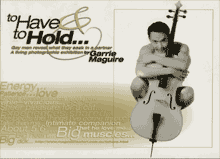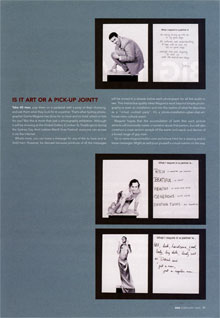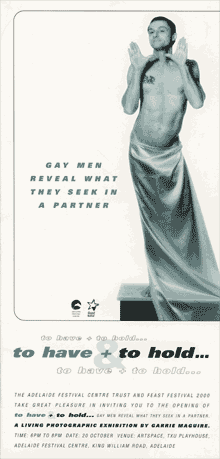 |
 |
 |
 |
 |
 |
 |
|
the work:
The group of people in this series are a cross-section of Sydney gay men. The group has been selected to reflect many diverse subcultures, body types, ages, disabilities and races, not an objectified representation of what gay men desire, nor the "cute" media stereotypes. The participants adopted their own poses and choose what they wore. They had the option to use one prop. That way, they got to represent themselves as they would like to be seen. The photographs are made on 5 x 4" Kodak Infrared film. This was
This show has many themes and nuances, one of which is about perverting the way the viewer judges the models/participants. Having both a photograph as well as a description of what the participant wanted in a partner, the viewer is judged as well judging. In order to engage a larger audience and provide an interactive element, the exhibition will also exist as a website. The diptych titles are hyperlinks slowing e-mail messages to be sent to the participants, this email is exhibited with the exhibition. For gay men, this dialogue is a rallying cry for the legal recognition of our relationships. It also aims to create an awareness from the broader public for our need for equal rights. Furthermore, it provides visibility to many men who are not usually represented by the mainstream gay community (or mainstream culture either). It challenges that community to see itself with a greater diversity. The exhibition expresses the humanity of gay men - their love, compassion and desire for partners in life. Beyond the gay community, it is men talking directly and openly about what they think is important in a relationship. In the Merchant of Venice Shakespeare sought to address issues about the common humanity of all people. Although the
play still makes me uncomfortable with its stereotyping of Jewishness, it contains one of the most moving cries for
recognition and respect. The Jewish moneylender Shylock says, almost in despair: Chris Sidoti was the Human Rights Commissioner with the Human Rights and EqualOpportunity Commission. |
Men, too, now construct their identities in terms of what they consume, From sports and cars, to movies, food and clothing. The sociopolitical emergence of gays within capitalist culture, with their frank patterns of consumption, has further challenged the traditional dichotomy that marks consumption as feminine and production as masculine.(1) CONTEMPORARY DATING GAMES are a complex set of social relations. Television shows dependent on commercial imperatives, such as Perfect Match, Weddings and Studs, orchestrate readymade dating rituals based on a self-conscious spectacle of consumerism. The problem with most such examples, of course, is that they only represent white heterosexual scenarios. As Joan Ockman points out, the modernist equation of production as masculine and consumption as feminine is destabilised in the context of postmodern capitalism because men are obvious consumers. Furthermore, 'the frank patterns of consumption' enacted by gay men create a much needed shift
Garrie Maguire articulates a fetishistic exchange of consumption through mechanical reproduction in his new series of photo works, To Have and To Hold. With matchmaking firmly inscribed on his mind, Maguire substitutes, for Cupid's bow and arrow, the similarly penetrative function of the camera. Maguire's men are photographed as (dis)play things, uniformly represented as precious commodity spectacles, perched atop a pedestal and accompanied by the occasional prop. What differentiates Maguire's dating game from the aforementioned televisual examples is his careful insistence on the exclusion of heterosexual norms and the inclusion of what is usually considered Other in Western culture, with regard to race, class, sexual identity and subcultural identification. Each portrait is accompanied by a shopping list of sorts. Don't deny it, we all have them. In direct contrast to the precious quality of the photographs are a series of written ideals that read like love sonnets, sleazy classifieds or casting calls. A viewer is encouraged not simply to look at the images and texts, but to cruise past them as if the gallery were a brightly-lit beat intended to illuminate and arouse. Perhaps a common characteristic may emerge 'which allows me to say: "that's my type!" "Just my type" or "not my type at all" -- cruising slogans: then is the lover merely a choosier cruiser who spends his life looking for his type?' The consummate sexual partner is not always such an arbitrary ideal. For one of Maguire's dating contestants, the familiar desire For someone 'tall, dark, handsome,' with a 'good body' is followed more explicitly by 'big dick, lively wit' as a prerequisite for the position. For another contestant, a more evocative requirement in a partner is simply 'a sentence 1 can't complete.' The visual and textual quest for mateship here is one that links the body (pleasure) with discourse (knowledge, power and resistance). Maguire continually disrupts ideals and stereotypes, while acknowledging that these very stereotypes shape desire. The contestants in Maguire's dating game do not always line up with the neurotic cultural ideals of what constitutes the perfect gay male, but they often do share similar visions of what should constitute the perfect partner. If dating is merely another form of consumption that depends on (reproducing identity, how do we account for the slippages that may occur between image and text, body and discourse, or, to complicate things further, image as text and body as discourse? Maguire's images are p, iductions of the body as a billboard, carefully arranged to advertise and attract like-minded individuals. Although Maguire has strategised familiar stereotypes, how can we be sure that the specific contestants have not included or excluded specific signifiers, props, costumes, fetishes and the like, in the hope that certain characteristics are visible while others remain garbed? It would be impossible to estimate the integrity or truth of the image, which is the main reason this project is so alluring. The only sure thing is that by being placed high on a pedestal, all the contestants are idealised in one way or another. Although the pedestal acts as a stage where private desires are made public, it does not necessarily separate the subject From the viewer. Instead, the pedestal/stage allows these contestants to dispense with inhibition. The only thing missing is a spotlight. The interactive element of Maguire's dating game makes sure that the pedestal/stage sexually charges his human products. If it were not possible to make contact with these men through email, Maguire's project would be exploitative, perhaps carnivalesque. It is the interactivity of this dating game that ensures a sense oF the narrative unfolding somewhere beyond the gallery walls. Readings of this project are endless because the imagination must work overtime and speculate on when, where and how the narrative is consummated. Whether we play the role of consumer or producer, contestant or applicant, the game of dating, like most narratives of desire, depends on the mechanics of fantasy. Maguire strips away normative ideals to do with what constitutes beauty and recreates an idiosyncratic fantasy of desire. Instead of playing one fantasy against another, he elevates his archive of dating contestants to a platform where anything (or nothing) can happen. Desperately seeking desire over disappointment and disgust, Garrie Maguire's fantasy tableau is propelled by a chain of elliptical narratives that emerge once the game is over. Notes 1. Joan Ockman, "Mirror Images: Technology, Consumption and the Representation of Gender in American Architecture since World War 1]," in Agrest, Conway, & Weisman (eds). The Sex of Architecture, New York: Harry N.Abrams.im,p.207. 2. Roland Barthes, A Lover's Discourse: Fragments, trans. R. Howard, London & New York: Penguin, 1777, p. 34. Daniel Mudie Cunningham is a writer, film maker and curator based in Sydney. He is currently writing a PhD on white trash aesthetics.
This is the third occasion that this exhibition has been shown in an art gallery, yet it has had a web based existence since January 2000. Before it opened at last year's Sydney Mardi Gras the project was on-line. It was launched simultaneously in chat-rooms based in Asia, Europe, Australasia and North America. As such it was always conceived as a web-based exhibition that invited email responses to each sitter's portrait and their personal text stating What I require in a partner. As you can all recognise this project asks something I know that we have all wondered of ourselves but perhaps not actually written down for others to read in a manner that is entirely not determinable or even controllable. Many of us have a web-based persona. Mostly, if there is no photograph of you, one will have a professional and or business web persona. This is not always the most fun. If there is a photograph available, or even an album of images, then you are sharing something of yourself that has suddenly become part of our world's gay encyclopedia of personal representation. For instance: many gay men can now be image-accessed as codes of a white fetish phrat, a black jock bottom, a spandex tattooed queerskin, or otherwise visually classified by an anonymous international regard for one's sexual research or proclivity for providing visual testimony to the complexity of masculine freedom. Am I not deeply superficial in suggesting that Garrie Maguire is not offering us a collaborative project with these men
in a pornesque erotodomicile of drained playmale clones? There is no Colt, no Bel Ami, no Chi Chi La Rue nor Cadinot fuck
factor observable here. There is no idealization of the ready-made subcutaneous pay per view erection. Neither is there any
The portraits in this project were not immediately recognised in chatrooms as being of men who actually live in Sydney Australia. The reasons for this result from the fact that they are studio-based portraits. Who they are as real men has not been polluted with the telling backgrounds of their homes or the environments that they work within. Imagine: if Garrie took your portrait at midnight on Saturday next, or at midday on Sunday next. It is highly likely, unless either portrait was an extreme close-up, that you would be surrounded by what we can call evidential indicators of your social experience. Your gay life's zone - but wait a moment I am prejudicing some of you - for I am assuming that you are all gay every way every day. In out and everywhere. Gidday Gay. Once upon a time, and not so long ago, it would have been idiotic to think that you could go to an exhibition, or visit a web site, and find a bunch of ordinary men who are extraordinary because they have decided to affirm who they are and what they desire in a partner within a project which an artist like Garrie has a website where you can write to all but one of the men in this project. They are aged from 17 to 70. They make up a complex diversity of ethnicity and body type. Imagine if you were one of these men and you received an email from someone you had never met that said that you had seen their portrait in Auckland as part of HERO. I am going to write to all but one of them. So my words to you the men of this project, to Garrie Maguire and his partner Martin, and to all of you here are some words once said by Gertrude Stein that great Jewish avatar of queer reality: Look Look at me Look at me now and here I am Congratulations Garrie. Welcome. Tena koutou katou. Talofa lava. Welcome to Tamakimakaurau. The land loved by many lovers. Ron Brownson, Tuesday, February 13, 2001 |
 |
 |
 |
 |
 |
 |
 |
 |
|
| Some Other Men | Occupation | Edges | toHave & toHold | Awaiting Approval | Gods + Warriors | re-Pat | BAD FiLM |
 chosen to render fine detail, to minimise differences in skin tone and to distort perceptions of age. Accompanying
each image is a text panel where the participant has described, in his own writing, what he requires in a partner.
The text is photocopied.
chosen to render fine detail, to minimise differences in skin tone and to distort perceptions of age. Accompanying
each image is a text panel where the participant has described, in his own writing, what he requires in a partner.
The text is photocopied.  Merchant of Venice. Here again there is a plea For recognition and respect based on our common humanity.
Merchant of Venice. Here again there is a plea For recognition and respect based on our common humanity.
 in the way we conceptualise not only production and consumption, but also masculine and feminine gender roles. 1f dating is merely another form of consumption, it depends on a reciprocal form of production -- namely, the subject's meticulous (re)production of his or her identity in such a way as to help ensure that their emotional and sexual requirements will be met.
in the way we conceptualise not only production and consumption, but also masculine and feminine gender roles. 1f dating is merely another form of consumption, it depends on a reciprocal form of production -- namely, the subject's meticulous (re)production of his or her identity in such a way as to help ensure that their emotional and sexual requirements will be met.  fetishisation of a powerful physiognomy seen celebrating the ideal symbols of spent desire - all of which have been emblems
for EuroHomo fantasy over more than half a millennium.
fetishisation of a powerful physiognomy seen celebrating the ideal symbols of spent desire - all of which have been emblems
for EuroHomo fantasy over more than half a millennium.